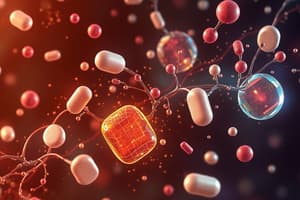Podcast
Questions and Answers
What is the primary mechanism of action of thiazides in the kidney?
What is the primary mechanism of action of thiazides in the kidney?
- Antagonism of aldosterone at intracellular cytoplasmic receptor sites
- Impairment of Na+ and Cl- reabsorption in the early distal tubule (correct)
- Blockage of Na+ transport channels
- Inhibition of the apical Na+-K-+2Cl- cotransporter
What is a common adverse effect of loop diuretics?
What is a common adverse effect of loop diuretics?
- Hyperkalemia
- Hypercalcemia
- Hypocalcemia
- Hypokalemia (correct)
Which of the following diuretics is used to treat calcium nephrolithiasis?
Which of the following diuretics is used to treat calcium nephrolithiasis?
- Triamterene
- Furosemide
- Spironolactone
- Thiazides (correct)
What is the mechanism of action of spironolactone?
What is the mechanism of action of spironolactone?
What is a common adverse effect of thiazides?
What is a common adverse effect of thiazides?
What is the primary effect of osmotic diuretics on the body?
What is the primary effect of osmotic diuretics on the body?
What is a common adverse effect of spironolactone?
What is a common adverse effect of spironolactone?
Why should potassium-sparing diuretics be used with caution in patients with renal dysfunction?
Why should potassium-sparing diuretics be used with caution in patients with renal dysfunction?
What is the primary mechanism of action of carbonic anhydrase inhibitors?
What is the primary mechanism of action of carbonic anhydrase inhibitors?
What is a potential consequence of using osmotic diuretics?
What is a potential consequence of using osmotic diuretics?
Flashcards are hidden until you start studying
Study Notes
Thiazides (Low Ceiling Diuretics)
- Impair Na+ and Cl- reabsorption in the early distal tubule, increasing Ca2+ reabsorption and K+ excretion
- Increase urinary excretion of Na+, Cl-, K+, and water, reducing ECF volume, cardiac output, and blood pressure
- Therapeutic uses: treatment of hypertension, mild edema, and calcium nephrolithiasis
- Adverse effects: hypokalemia, hyperuricemia, hyperglycemia, and hyperlipidemia
Loop Diuretics (Furosemide, Bumetanide, Torsemide, Ethacrynic acid)
- Inhibit the apical Na+-K+-2Cl- cotransporter in the thick ascending limb of the loop of Henle
- Therapeutic effects: treatment of severe edema, pulmonary edema, acute renal failure, and hypercalcemia
- Adverse effects: profound ECFV depletion, hypokalemia, metabolic alkalosis, hypomagnesemia, hypocalcemia, hyperuricemia, and ototoxicity
Potassium-Sparing Diuretics
- Mechanisms of action:
- Spironolactone: antagonizes aldosterone at intracellular cytoplasmic receptor sites, preventing Na+ reabsorption and K+ and H+ secretion
- Triamterene and amiloride: block Na+ transport channels, decreasing Na+/K+ exchange
- Therapeutic uses: induction of diuresis, treatment of secondary hyperaldosteronism, heart failure, resistant hypertension, ascites, and polycystic ovary syndrome
- Adverse effects: gastric upset, gynecomastia, menstrual irregularities, hyperkalemia, nausea, lethargy, and mental confusion
Osmotic Diuretics (Mannitol, Urea)
- Mechanism of action: increase osmolarity of tubular fluid, resulting in osmotic diuresis
- Therapeutic uses: treatment of patients with increased intracranial pressure or acute renal failure due to shock, drug toxicities, and trauma
- Adverse effects: extracellular water expansion and dehydration, hyponatremia, and hypernatremia
Carbonic Anhydrase Inhibitors (Acetazolamide)
- Mechanism of action: inhibit carbonic anhydrase in the proximal tubular epithelium, decreasing ability to exchange Na+ for H+
- Result: mild diuresis, increased urinary pH, and hyperchloremic metabolic acidosis
- Therapeutic uses: treatment of glaucoma, mountain sickness, and idiopathic intracranial hypertension
Studying That Suits You
Use AI to generate personalized quizzes and flashcards to suit your learning preferences.




